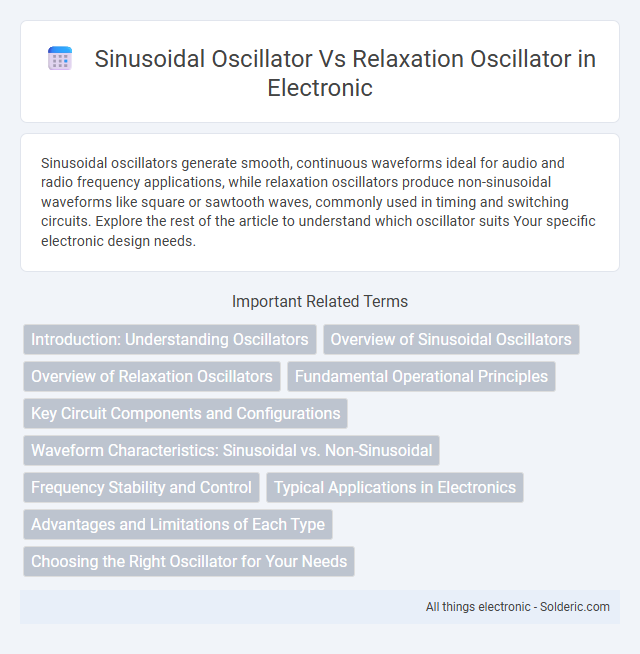Sinusoidal oscillators generate smooth, continuous waveforms ideal for audio and radio frequency applications, while relaxation oscillators produce non-sinusoidal waveforms like square or sawtooth waves, commonly used in timing and switching circuits. Explore the rest of the article to understand which oscillator suits Your specific electronic design needs.
Comparison Table
| Feature | Sinusoidal Oscillator | Relaxation Oscillator |
|---|---|---|
| Waveform Output | Continuous sine wave | Non-sinusoidal (square, sawtooth, or triangular) |
| Frequency Range | High-frequency stability | Typically low to medium frequency |
| Oscillation Principle | Resonant LC or crystal circuits | Charging and discharging of capacitor |
| Application | Signal generators, communication systems | Timing circuits, flashers, pulse generation |
| Frequency Stability | High stability and precision | Lower stability, frequency varies with component tolerances |
| Complexity | More complex design and components | Simple design, fewer components |
| Examples | Wien bridge oscillator, Hartley oscillator | Astable multivibrator, Schmitt trigger oscillator |
Introduction: Understanding Oscillators
Sinusoidal oscillators generate smooth, continuous waveforms ideal for applications requiring stable frequency signals, such as communication systems and signal processing. Relaxation oscillators produce non-sinusoidal waveforms like square or triangular waves, suited for timing circuits and pulse generation. Understanding these differences helps you select the right oscillator type based on waveform shape and application requirements.
Overview of Sinusoidal Oscillators
Sinusoidal oscillators generate continuous, smooth sine waves ideal for AC signal generation, signal processing, and communication systems. Typical designs include the Wien bridge, Hartley, and Colpitts oscillators, which rely on linear feedback to maintain stable oscillations at a specific frequency. Your choice of a sinusoidal oscillator ensures low distortion and precise frequency control critical for applications requiring clean waveform outputs.
Overview of Relaxation Oscillators
Relaxation oscillators generate non-sinusoidal waveforms such as square, triangular, or sawtooth waves by charging and discharging a capacitor through a resistor, creating a repetitive, non-linear voltage change. Unlike sinusoidal oscillators, which produce smooth sinusoidal signals via continuous energy transfer in resonant circuits, relaxation oscillators rely on threshold-based switching elements like comparators or transistors. Your choice between these oscillators depends on the required waveform shape, frequency stability, and application, with relaxation oscillators preferred for timing and waveform generation where simple, sharp transitions are needed.
Fundamental Operational Principles
A sinusoidal oscillator generates continuous, smooth waveforms using feedback circuits that satisfy the Barkhausen criteria, relying on frequency-selective components like capacitors and inductors to produce pure sine waves. A relaxation oscillator operates by charging and discharging energy storage elements, such as capacitors, through nonlinear components, creating non-sinusoidal waveforms like square or sawtooth signals. Your choice between these oscillators depends on the specific waveform requirements and stability needed for your application.
Key Circuit Components and Configurations
Sinusoidal oscillators primarily use capacitors, inductors, and resistors arranged in feedback loop configurations like RC phase shift, Wien bridge, or LC tank circuits to generate smooth, continuous sine waves. Relaxation oscillators rely on nonlinear components such as unijunction transistors, operational amplifiers, or Schmitt triggers combined with resistors and capacitors to produce non-sinusoidal, periodic waveforms like square or triangular waves through charging and discharging cycles. The critical distinction hinges on sinusoidal oscillators' reliance on frequency-selective networks versus relaxation oscillators' exploitation of threshold-triggered switching mechanisms.
Waveform Characteristics: Sinusoidal vs. Non-Sinusoidal
Sinusoidal oscillators generate smooth, continuous waveforms characterized by a single frequency and uniform amplitude, essential for applications requiring low distortion signals such as communication systems. Relaxation oscillators produce non-sinusoidal waveforms like square, triangular, or sawtooth waves, characterized by rapid transitions and variable frequency stability, suitable for timing and pulse generation tasks. The distinct waveform characteristics define their suitability: sinusoidal oscillators excel in precision signal generation, while relaxation oscillators are preferred for switching and clocking circuits.
Frequency Stability and Control
Sinusoidal oscillators offer high frequency stability and precise control due to their reliance on steady-state resonance conditions, making them ideal for applications requiring consistent sinusoidal waveforms. Relaxation oscillators, while simpler and capable of generating non-sinusoidal waveforms, exhibit less frequency stability because their frequency depends largely on charging and discharging times of reactive components, which can vary with temperature and component aging. For applications demanding robust frequency control, your choice should favor sinusoidal oscillators to maintain consistent and accurate frequency output.
Typical Applications in Electronics
Sinusoidal oscillators are typically used in communication systems, signal generators, and audio equipment where stable and pure frequency signals are required. Relaxation oscillators find applications in timing circuits, pulse generation, and electronic flashing lights, benefiting from their simple design and ability to produce non-sinusoidal waveforms. Both oscillators play crucial roles in electronic devices, with sinusoidal types favored for analog signal processing and relaxation types suited for digital timing and control functions.
Advantages and Limitations of Each Type
Sinusoidal oscillators generate stable, pure sine waves ideal for high-frequency and communication applications, offering low distortion but often require complex tuning and are sensitive to component variations. Relaxation oscillators produce non-sinusoidal waveforms like square or triangular waves, are simpler to design, and excel in timing or waveform generation but suffer from higher harmonic content and less frequency stability. Choosing between them depends on the need for waveform purity versus circuit simplicity and application-specific frequency accuracy.
Choosing the Right Oscillator for Your Needs
Selecting the right oscillator depends on the waveform requirements and application sensitivity; sinusoidal oscillators produce smooth, continuous waveforms ideal for communication and signal processing, while relaxation oscillators generate non-sinusoidal, often square or triangular waveforms suitable for timing and switching circuits. Sinusoidal oscillators offer stable frequency with low distortion, crucial for audio and RF applications, whereas relaxation oscillators excel in simplicity, low cost, and ease of frequency adjustment in pulse generation and waveform shaping. Understanding the trade-offs in waveform purity, frequency stability, and circuit complexity helps determine the best oscillator type for specific electronic design needs.
sinusoidal oscillator vs relaxation oscillator Infographic

 solderic.com
solderic.com